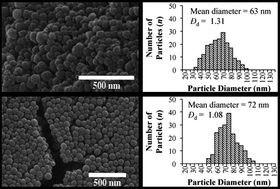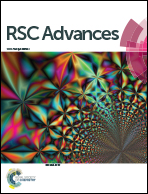Surfactant-free synthesis of sub-100 nm poly(styrene-co-divinylbenzene) nanoparticles by one-step ultrasonic assisted emulsification/polymerization†
Abstract
The synthesis of sub-100 nm polymeric nanoparticles in a surfactant-free form is currently very challenging due to the oil nanoemulsion instability in polar solvents and in the absence of stabilizers. Here we report for the first time the surfactant-free synthesis method of poly(styrene-co-divinylbenzene) nanoparticles in an aqueous environment using ultrasonic radiation. This method involves emulsification of the monomers mixture in water, followed by free-radical polymerization under pulsed or continuous acoustic fields. The local energy produced in water by cavitation effects was sufficient to: (1) generate and stabilize the monomer nanoemulsion due to mechanical forces, and (2) drive the radical polymerization due to the heat generated. The average size of the final polymer nanoparticles obtained depended: (i) inversely on the monomer/water interfacial energy, emulsification power, and (ii) directly on temperature, amount of initiator and monomer solubility. The polymer nanoparticle size distribution and shape was considerably improved upon the addition of a co-polymerizable surfactant.


 Please wait while we load your content...
Please wait while we load your content...